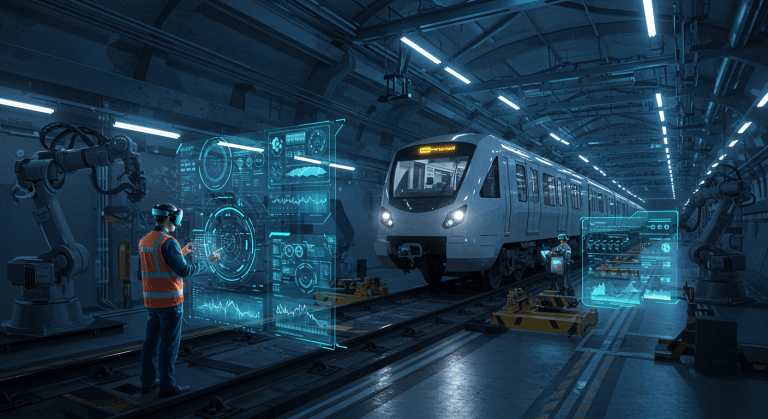Predictive maintenance has emerged as a powerful strategy for industrial operations. But while collecting and analyzing equipment data is no longer a novelty, doing so reliably in harsh, remote, or high-noise environments still presents serious challenges. That’s where Edge AI—artificial intelligence deployed directly at the edge of the network—proves to be a game-changer.
At Delphisonic, we’ve engineered our AI-based predictive maintenance systems specifically for railways, energy infrastructure, and heavy machinery operating in extreme environments. Whether it’s a freezing locomotive axle in Kazakhstan or a high-vibration gearbox on a wind turbine, our edge-enabled DS-Track sensors are built to survive and perform.
What Is Edge AI and Why Does It Matter?
Edge AI refers to the deployment of artificial intelligence algorithms directly on local devices (sensors or embedded processors) rather than relying entirely on cloud computing. This means that the analysis of raw data—such as vibration, acoustic signals, or temperature—can be performed on-site and in real time, without delays or constant data transfer to remote servers.
Edge AI is particularly valuable in:
- Remote areas with limited or unreliable connectivity
- High-latency or bandwidth-constrained systems
- Time-sensitive applications, like detecting a bearing fault before catastrophic failure
Challenges of Harsh Environments
Operating in harsh environments often means dealing with:
- Extreme temperatures (from -40°C to +120°C)
- High levels of vibration and mechanical shock
- Dust, humidity, oil exposure
- Electromagnetic interference
- Lack of stable internet or power supply
Traditional predictive maintenance systems fail in these conditions because they depend on centralized cloud platforms or require regular human inspection. Delphisonic’s Edge AI solution addresses this gap.
Delphisonic’s Edge AI Architecture
Our system architecture is designed to process critical maintenance data directly on the sensor:
- Sensor Layer (DS-Track series)
- Analog MEMS sensors (e.g., ADXL1002/1004) with up to ±1000gE range
- High-frequency sampling (up to 50kHz)
- Operates in -40°C to +120°C, IP69-rated
- Embedded AI Layer
- Band-pass filtering
- Envelope extraction using Hilbert Transform
- Fast Fourier Transform (FFT) for frequency domain analysis
- Machine learning-based anomaly detection algorithms
- Communication Layer
- Supports BLE, Wi-Fi, LoRa, and NB-IoT
- Optional integration with Single Pair Ethernet (SPE) for data + power transmission
- Cloud transmission only when fault thresholds are exceeded (reduces bandwidth)
Real-Time Fault Detection at the Edge
Delphisonic’s embedded software is capable of detecting:
- Gearbox tooth wear
- Bearing faults (inner race, outer race, ball pass)
- Misalignment and resonance
- Wheelset unbalance or cracks
- Overheating in traction motors
Because all signal processing and anomaly detection happens at the edge, response times are reduced to milliseconds, enabling real-time alerting and automatic mitigation (e.g., speed reduction or shutdown).
Use Case: Freight Locomotives in Kazakhstan
In our pilot deployment with Alstom-operated locomotives in Kazakhstan:
- Each locomotive had 8 axle boxes monitored with DS-Track sensors.
- External conditions reached -35°C in winter and +45°C in summer.
- Connectivity was limited in desert and steppe routes.
Results:
- The edge-processed AI system detected early-stage bearing pitting.
- Maintenance crews were alerted via satellite SMS gateway.
- Avoided what would have been a critical failure costing $75,000+.
Benefits of Edge AI for Predictive Maintenance
| Feature | Edge AI-Based PdM | Traditional PdM |
| Connectivity Dependency | Low | High |
| Latency | Milliseconds | Seconds to Minutes |
| Data Volume | Minimal (processed locally) | Massive (raw data uploads) |
| Power Efficiency | High | Medium |
| Scalability in Remote Areas | Excellent | Limited |
Beyond Rail: Wind, Oil, Marine Applications
Our Edge AI solutions are now being piloted in:
- Offshore wind turbines: where vibration analysis is done 60 meters above the sea, with no stable internet.
- Industrial pumps: where local vibration spikes trigger maintenance logs without delay.
- Oil platform generators: where the sensors are exposed to salt, pressure, and mechanical shocks.
Each of these use cases shares one thing in common: they cannot wait for the cloud to decide.
Conclusion
Harsh environments are no longer barriers to smart maintenance. With Delphisonic’s Edge AI-based predictive maintenance systems, rail and industrial operators can ensure safety, reliability, and efficiency—anytime, anywhere.
Edge AI is not just a tool; it’s the future of autonomous diagnostics.
Want to explore how Edge AI can help your operation? Contact us to schedule a demo or request a technical whitepaper.
→ www.delphisonic.com/solutions






